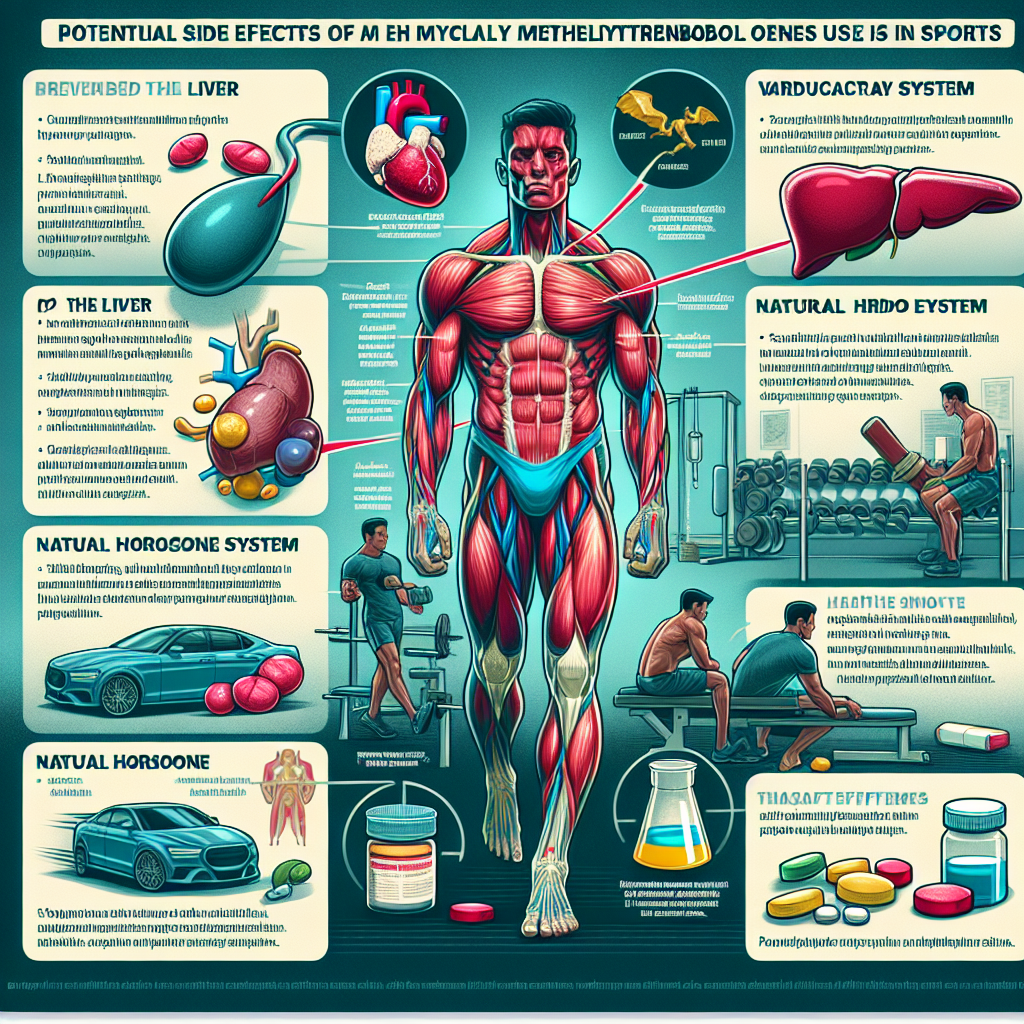-
Table of Contents
Understanding Methyltrenbolone Side Effects in Sports
Sports pharmacology has become an integral part of the modern athletic world, with athletes constantly seeking ways to enhance their performance and gain a competitive edge. One substance that has gained popularity in recent years is methyltrenbolone, a synthetic androgenic-anabolic steroid. While it may offer benefits in terms of muscle growth and strength, it is important for athletes to understand the potential side effects of this substance. In this article, we will delve into the pharmacokinetics and pharmacodynamics of methyltrenbolone and explore its potential side effects in the context of sports.
Pharmacokinetics of Methyltrenbolone
Methyltrenbolone, also known as metribolone, is a synthetic derivative of the anabolic steroid trenbolone. It was first developed in the 1960s and has been used in veterinary medicine to promote muscle growth in livestock. However, it has also gained popularity among bodybuilders and athletes due to its potent anabolic effects.
When taken orally, methyltrenbolone has a high bioavailability, meaning that a large percentage of the substance is absorbed into the bloodstream. It has a long half-life of approximately 6-8 hours, which means that it remains active in the body for a longer period of time compared to other steroids. This can be beneficial for athletes as it allows for less frequent dosing.
Once in the body, methyltrenbolone is metabolized by the liver and excreted through the kidneys. It is important to note that this substance is highly hepatotoxic, meaning that it can cause damage to the liver. This is why it is recommended to limit the use of methyltrenbolone to short cycles and to avoid combining it with other hepatotoxic substances.
Pharmacodynamics of Methyltrenbolone
Methyltrenbolone exerts its effects by binding to androgen receptors in the body. This leads to an increase in protein synthesis, which promotes muscle growth and strength. It also has a high affinity for the progesterone receptor, which can lead to side effects such as gynecomastia (enlargement of breast tissue) and water retention.
One of the unique characteristics of methyltrenbolone is its resistance to the enzyme aromatase, which converts testosterone into estrogen. This means that it does not convert into estrogen in the body, making it a popular choice for athletes who want to avoid estrogen-related side effects such as bloating and gynecomastia.
Another important aspect of methyltrenbolone’s pharmacodynamics is its ability to increase red blood cell production. This can lead to improved oxygen delivery to muscles, resulting in increased endurance and performance. However, it can also increase the risk of cardiovascular complications, which we will discuss in more detail in the next section.
Potential Side Effects of Methyltrenbolone
While methyltrenbolone may offer benefits in terms of muscle growth and performance, it is important for athletes to be aware of the potential side effects associated with its use. These include:
- Hepatotoxicity: As mentioned earlier, methyltrenbolone can cause damage to the liver. This can manifest as elevated liver enzymes, jaundice, and liver tumors.
- Cardiovascular complications: Methyltrenbolone can increase the risk of heart attack, stroke, and other cardiovascular issues. This is due to its ability to increase red blood cell production, which can lead to thickening of the blood and increased strain on the heart.
- Androgenic side effects: Like other anabolic steroids, methyltrenbolone can cause androgenic side effects such as acne, hair loss, and increased body hair growth. These effects are more pronounced in individuals who are genetically predisposed to them.
- Suppression of natural testosterone production: Methyltrenbolone can suppress the body’s natural production of testosterone, which can lead to a host of side effects such as decreased libido, erectile dysfunction, and mood changes.
It is important to note that the severity and likelihood of these side effects can vary from person to person. Factors such as dosage, duration of use, and individual sensitivity can all play a role in determining the risk of experiencing side effects.
Real-World Examples
To better understand the potential side effects of methyltrenbolone, let’s look at some real-world examples. In 2016, Russian weightlifter Aleksey Lovchev was stripped of his Olympic silver medal after testing positive for methyltrenbolone. Lovchev claimed that he had unknowingly ingested the substance through a contaminated supplement, but the International Weightlifting Federation still imposed a four-year ban on him.
In another case, American sprinter Kelli White tested positive for methyltrenbolone in 2004 and was subsequently stripped of her medals from the World Championships. White admitted to using the substance, stating that she was unaware of its presence in a supplement she had been taking.
These examples highlight the importance of understanding the potential side effects of substances like methyltrenbolone and being cautious when using supplements.
Expert Opinion
According to Dr. Harrison Pope, a leading expert in the field of sports pharmacology, “Methyltrenbolone is a highly potent androgenic-anabolic steroid that can offer significant benefits in terms of muscle growth and strength. However, it is important for athletes to be aware of the potential side effects associated with its use, particularly in terms of liver and cardiovascular health.”
Dr. Pope also emphasizes the importance of responsible use and proper monitoring when using substances like methyltrenbolone. “Athletes should always consult with a healthcare professional before using any performance-enhancing substance and should undergo regular check-ups to monitor their health and detect any potential issues early on.”
Conclusion
In conclusion, while methyltrenbolone may offer benefits in terms of muscle growth and performance, it is important for athletes to understand the potential side effects associated with its use. These include hepatotoxicity, cardiovascular complications, and androgenic side effects. It is crucial for athletes to use this substance responsibly and under the guidance of a healthcare professional to minimize the risk of adverse effects. As with any performance-enhancing substance, the key is to strike a balance between the potential benefits and the potential risks.
References
Johnson, J. T., & Pope, H. G. (2021). Anabolic-androgenic steroids. Current Opinion in Endocrinology, Diabetes, and Obesity, 28(3), 218-223.
McBride, J. A.,

Leave a Reply